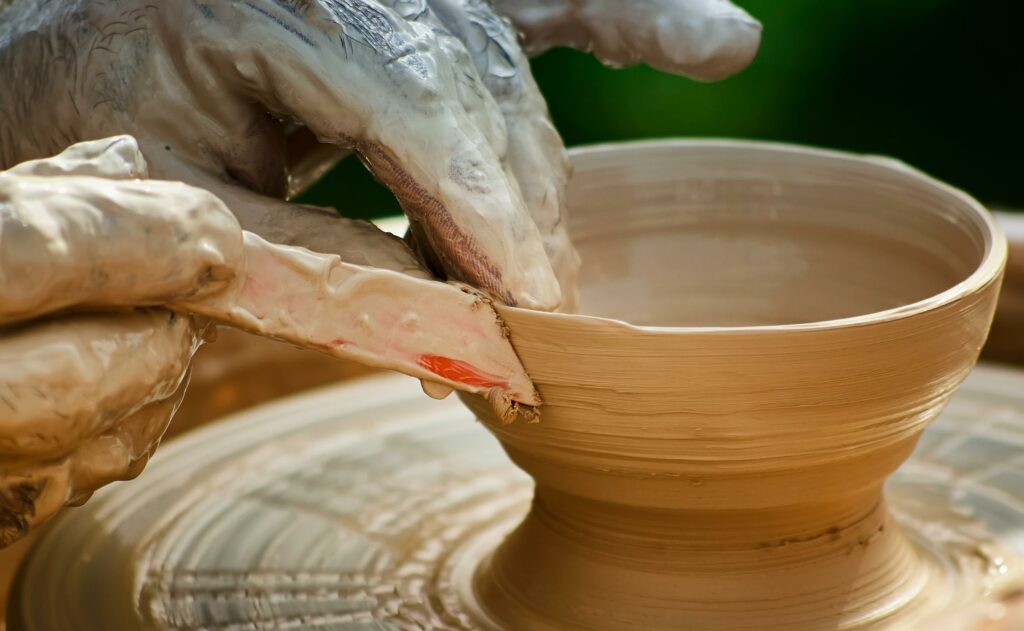
For Nashville’s rapidly growing pottery community, the art of glazing is as vital as shaping the clay itself. Glazing not only adds color and texture to pottery but also plays a crucial role in the final outcome, influencing the piece’s durability and aesthetic appeal. Whether you’re a seasoned ceramicist or just starting out, understanding the fundamentals of glazing can elevate your craft to new heights. So, let’s dive into the world of glazing and uncover its secrets for the local clay enthusiast.
Understanding Glazes
Pottery glazes are essentially thin coatings of glass that are applied to pottery before firing. They serve multiple purposes, including adding color, creating surface textures, and sealing the porous clay body to make it waterproof and food-safe. Glazes consist of three main components: fluxes, glass formers, and stabilizers. Fluxes lower the melting point of the glaze, glass formers provide the main structure, and stabilizers prevent the glaze from running off the pot during firing.
Types of Glazes
In the world of pottery, there are countless types of glazes, each with its unique characteristics and firing requirements. Some of the most common types include:
- Underglazes: These are applied to the pottery before the final glaze to create intricate designs or patterns. Underglazes come in a variety of colors and can be used alone or in combination with other glazes.
- Opaque Glazes: These glazes produce a solid, non-transparent finish and are often used for functional pottery or to cover imperfections in the clay body.
- Transparent Glazes: These glazes allow the natural color of the clay to show through while adding a glossy finish. They’re ideal for showcasing intricate carving or texture on the surface of the pottery.
- Textured Glazes: These glazes contain materials such as sand, ash, or crystals, which create interesting textures and effects when fired. They’re perfect for adding depth and visual interest to your pottery.
Application Techniques
Applying glazes requires precision and attention to detail to achieve the desired results. Here are some common techniques used by pottery enthusiasts in Nashville:
- Brushing: Using a soft-bristled brush, glaze is carefully applied to the surface of the pottery in smooth, even strokes. This technique allows for greater control over the application and can create subtle variations in color and texture.
- Dipping: Pottery is dipped directly into a bucket or vat of glaze, ensuring complete coverage of the entire surface. Dipping is ideal for creating uniform finishes and is commonly used for larger pieces or production pottery.
- Spraying: Glaze is sprayed onto the pottery using an airbrush or spray gun, resulting in a fine, even coat. This technique is favored for achieving gradient effects or for covering intricate forms with delicate details.
- Pouring: Glaze is poured directly onto the pottery, allowing it to flow and pool in certain areas. This technique produces organic, unpredictable patterns and is often used for decorative pieces or abstract designs.
Firing and Finishing
Once the pottery has been glazed, it’s time for the final firing. The firing process is crucial, as it transforms the raw glaze materials into a durable, glassy surface. Most glazes require specific firing temperatures and conditions to achieve the desired results, so be sure to follow the manufacturer’s instructions carefully.
After firing, your pottery may require additional finishing touches, such as sanding rough edges or adding additional decorative elements. Take your time to inspect each piece closely and make any necessary adjustments before declaring it finished.
Conclusion
Glazing is an essential skill for any pottery enthusiast in Nashville. By understanding the fundamentals of glaze composition, application techniques, and firing processes, you can unlock endless possibilities for creativity and expression in your ceramic work. So, roll up your sleeves, get your hands dirty, and let your imagination run wild as you explore the fascinating world of glazing in Music City.




Comments are closed.